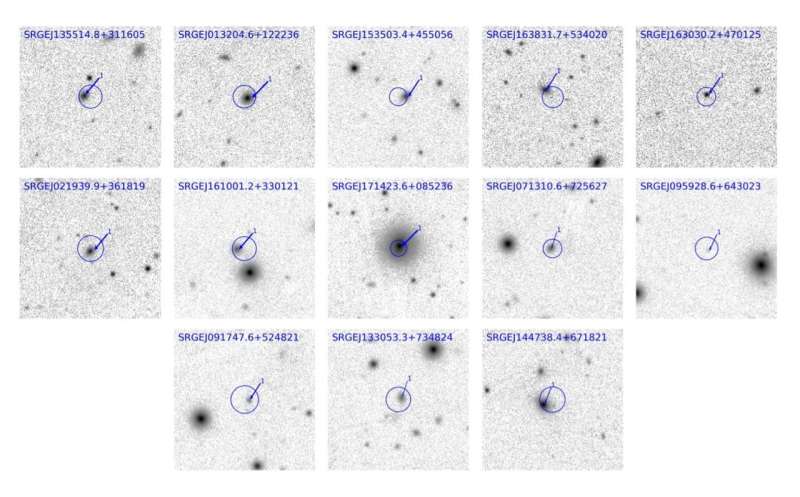August 12, 2021 report
Spektr-RG spacecraft detects its first tidal disruption events

Using the eROSITA telescope onboard the Spektr-RG (SRG) spacecraft, astronomers have detected 13 new tidal disruption events (TDEs). This is the first time when Spektr-RG identifies such events. The discovery is reported in a paper published August 5 on the arXiv pre-print server.
TDEs are astronomical phenomena that occur when a star passes close enough to a supermassive black hole and is pulled apart by the black hole's tidal forces, causing the process of disruption. Such tidally disrupted stellar debris starts raining down on the black hole and radiation emerges from the innermost region of accreting debris, which is an indicator of the presence of a TDE.
For astronomers and astrophysicists, TDEs are potentially important probes of strong gravity and accretion physics, providing answers about the formation and evolution of supermassive black holes.
The Spektr-RG spacecraft was launched into space in July 2019. Its eROSITA telescope is expected to find hundreds to thousands TDEs during eRASS (eROSITA all-sky survey). A team of astronomers led by Sergey Sazonov of the Russian Academy of Sciences, reports that the first TDEs were identified by Spektr-RG during the first weeks of the eRASS survey.
"We present the first sample of tidal disruption events (TDEs) discovered during the on-going SRG all-sky survey," the researchers wrote in the paper.
The 13 new events reported in the study were initially selected among the multitude of X-ray transients identified by eROSITA during its second scan of the sky—between June 10 and December 14, 2020. Afterward, they have been confirmed as TDEs by optical follow-up observations using a set of ground-based facilities.
In general, the newly found TDEs have properties similar to those of TDEs detected by previous X-ray missions. Particularly interesting is a TDE designated SRGE J144738.4+671821, which, unlike the remaining 12, continued to brighten after its discovery for at least another six months.
The most distant TDE in the sample is the one known as SRGE J163831.7+534020 as it occurred at a redshift of approximately 0.581. This means that eRASS has already expanded the horizon of TDE X-ray detectability by a factor of about four compared to the ROSAT all-sky survey, which was conducted three decades ago.
According to the research, four of the 13 TDEs have shown a brightening in their long-term optical light curves, concurring with or preceding the X-ray outburst. The remaining nine events showcase no signs of optical activity associated with stellar tidal disruption in existing photometric and spectroscopic data. Additionally, all of the TDEs reported in the paper are optically faint in the sense that their estimated optical/X-ray luminosity ratio is less than 0.3.
Summing up the results, the scientists disclosed how many new TDE discoveries they expect from eROSITA in the near future.
"The SRG all-sky survey is to continue until the end of 2023, opening up exciting opportunities for TDE studies. In particular, we plan to lower our detection threshold for such events by a factor of ∼ 2, which should increase the TDE discovery rate by eROSITA by a factor of ∼ 3. This implies that ∼ 700 TDEs can be found by the end of the 4-year SRG survey over the entire sky," the wrote in the study.
More information: S. Sazonov et al, First tidal disruption events discovered by SRG/eROSITA: X-ray/optical properties and X-ray luminosity function at z<0.6, arXiv:2108.02449 [astro-ph.HE] arxiv.org/abs/2108.02449
© 2021 Science X Network




















